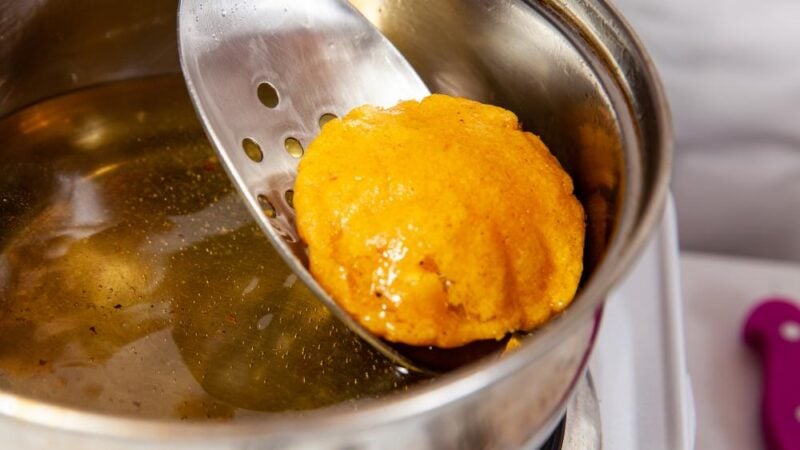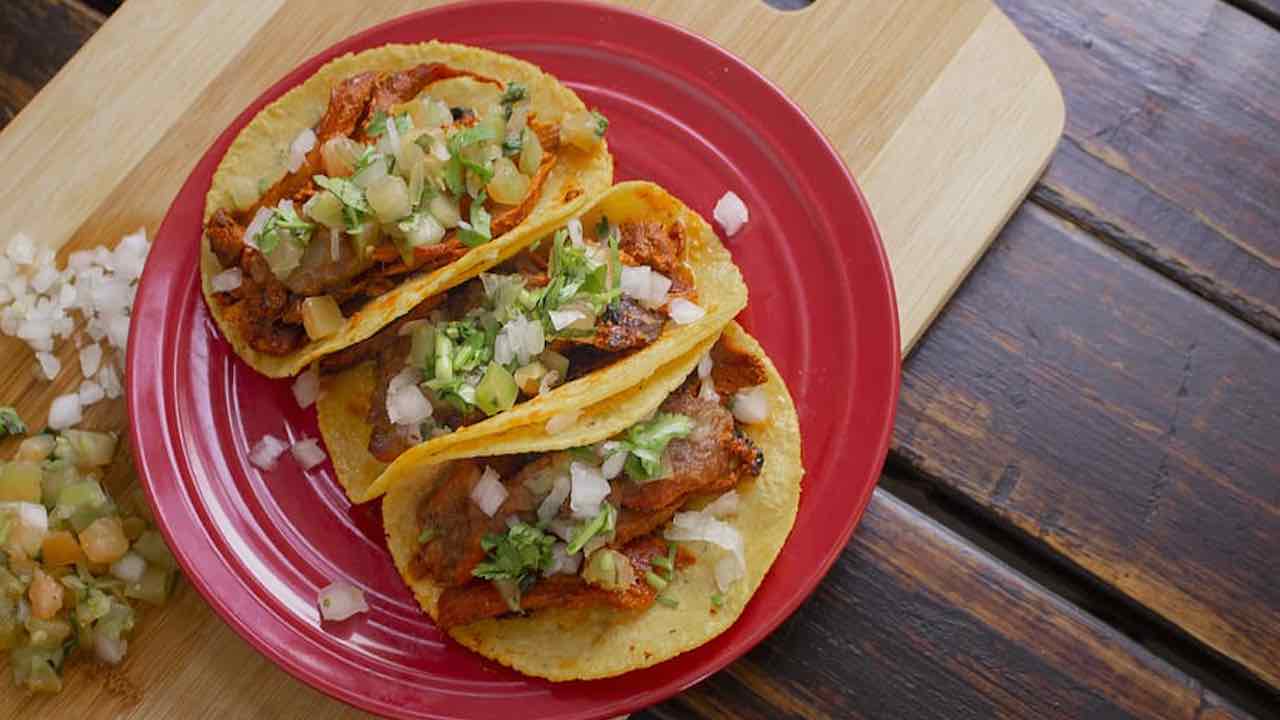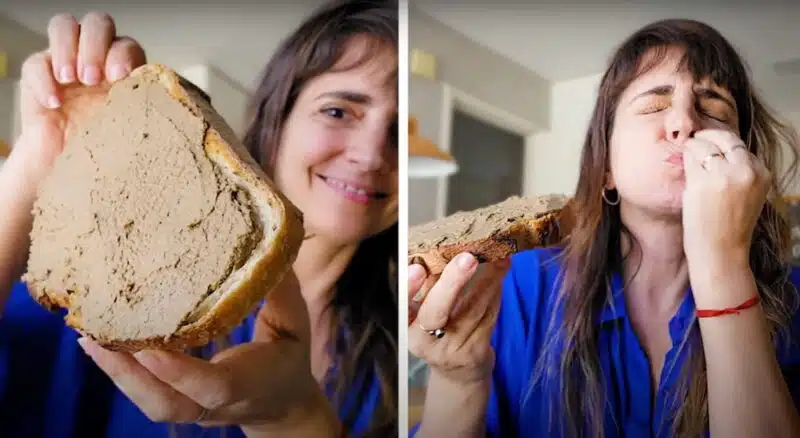Welcome to Paulina Cocina! On this blog, we love recipes steeped in family tradition, and the egg arepa is one of those treats passed down from generation to generation .
In this article, we'll explore the world of the coastal egg arepa: its origin, its invention, the best tips for preparing it, the details to keep in mind when freezing it, and, of course, a step-by-step recipe for egg arepas to make at home and delight in this symbol of Colombian gastronomy.
Content table
About the egg arepa
The egg arepa, a treasure of Colombian coastal cuisine, is much more than a simple bite. This delicacy is famous for its crispy texture on the outside and moist inside , creating a unique sensorial experience with every bite.
Its preparation varies slightly in different regions, but the essence always remains: a perfect mix of corn arepa, filled with egg and fried, which delights the senses of those who try it .
The coastal egg arepa
Particularly traditional in the Colombian coastal region, the egg arepa is a delicious invention . It's simple to prepare and requires only a few ingredients.
Its characteristic cornmeal dough wrapper houses a hard-boiled egg, which melts in your mouth at first bite . An explosion of flavors that transports diners directly to the sun-drenched beaches of the coast.
The coastal egg arepa is the perfect combination of tradition and culinary creativity, which can be enjoyed for breakfast, a summer lunch, or a late-night snack with a beer .
The origin of the Colombian egg arepa
The egg arepa recipe originates from the Caribbean region and is especially popular in the municipality of Luruaco, which claims to be the place where it was created . Also known as "arepaehuevo," this dish even has its own celebration in that city.
Every June, the Egg Arepa Festival in Luruaco, where expert chefs compete over three days in different categories of coastal egg arepas. Its humble yet flavorful roots make it an authentic expression of the country's culinary richness.

Who invented the egg arepa?
Although it is difficult to attribute the invention of the egg arepa to a single person, there is a legend that attributes its creation to a cook from Luruaco, Pabla Melgarejo, who cooked arepas to feed her family , and who in turn passed on the recipe for this original creation to her daughter, a well-known arepa maker in the area.
Beyond the legends, its invention is closely linked to family and community traditions, as this recipe has been passed down from generation to generation , enriched with stories and culinary secrets that give it that unique and unmistakable touch.
The art of preparing egg arepas
Making egg arepas isn't complicated, but it does require certain kitchen skills and, above all, some dedication. Key factors include mixing the dough, resting time, assembling the arepa, and cooking it precisely .
The temperature of the oil is also important when frying, as is the art of placing the egg inside the arepa while it's still hot, taking care not to burn yourself! The egg arepa isn't just a dish; it's a culinary masterpiece that you can recreate in the comfort of your own home.
Tips for perfect egg arepas
- Check the oil temperature. It should be very hot, but not so hot that it starts to smoke.
- Seal the arepas well to prevent the egg from escaping during the second frying.
- Cook the arepa for 2 or 3 minutes before filling it and 2 or 3 minutes with the egg.
- You can adjust the size of the arepas according to personal preferences , but make sure they are large enough to completely enclose the egg.
- Experiment with different sauces and accompaniments to add a personal touch.
- An alternative way to cook it can be to prepare the fried egg beforehand , covering it with two arepas and frying it.
How to make egg arepas to freeze?
If you're wondering how to preserve this culinary treasure , the answer is simple: frozen . Even in Colombia, it's common to find commercial versions in this state.
This process ensures that we can enjoy the essence of the Colombian egg arepa at any time, always ready to eat. Here are some steps to keep in mind:
- Cool completely: This prevents condensation from forming and helps maintain its original texture when defrosted.
- Wrap individually: Seal each piece well to prevent air from entering, which could cause loss of quality.
- Double protection: Place the wrapped arepas in freezer bags or airtight containers. This double layer of protection helps prevent freezer burn and maintains freshness.
- Label and date: To easily know until what date we can consume them.
- Storage Time: Coastal egg arepas can be stored in the freezer for up to three months without losing their authentic flavor. However, the sooner they are consumed, the better, to maintain their freshness.
- Defrost and reheat: To enjoy frozen egg arepas, simply remove them from the freezer and let them thaw in the refrigerator overnight. Heat them in a preheated oven at 180°C for approximately 10 minutes, or until thoroughly heated.
The best accompaniments for egg arepas
- Fresh Guacamole : The creaminess of the guacamole contrasts perfectly with the crunchy texture of the arepas.
- Spicy tomato sauce: Provides a vibrant and fiery touch.
- Crumbled fresh cheese: A little crumbled fresh cheese inside the arepas along with the egg, for an explosion of flavor.
- Traditional Hogao: Hogao, a mixture of tomato, onion, and seasonings, is a classic choice that enhances the flavor of egg arepas.
- Sliced avocado: Provides a creamy texture and a mild flavor.
- Garlic and Cilantro Sauce: Blend chopped garlic, fresh cilantro, lemon juice, and a touch of olive oil to create a refreshing sauce that enhances the flavors of the arepas.
- Colombian ajiaco sauce : A mixture that will give a spicy and refreshing touch to the arepa.
- Fresh Salad : A good arugula and lettuce salad provides the freshness needed to combine with the arepas.
Seguime on Instagram ( here )
And on YouTube I upload new videos every week ( click here )
Colombian egg arepa recipe
Yield: 6 portions
Preparation: 1 hour
Ingredients
- 2 cups of precooked cornmeal
- 1 cup of warm water
- 1 teaspoon of salt
- 1 teaspoon of sugar
- 4 eggs
- Frying vegetable oil
How to make coastal egg arepa step by step
- In a large bowl, combine the precooked cornmeal with the salt and sugar. Gradually add the warm water while mixing the dough with your hands. The consistency should be soft and malleable.
- Divide the dough into walnut-sized balls and let rest for a few minutes.
- Take a ball of dough and form it into a flat disc in the palm of your hands, making sure it's of a uniform thickness.
- Heat a generous amount of oil in a deep frying pan and submerge the arepas, making sure they have enough space. Cook for about 2 minutes until they puff up. Carefully remove and let cool for a few minutes.
- Make a small hole in the end of the arepa. Place a raw egg in a container with a spout, preferably a pitcher or narrow glass, and add the egg inside each arepa. Close carefully.
- Dip each arepa in oil again and cook for 2 or 3 more minutes.
- Remove the egg arepas from the pan and place them on paper towels. Let them rest for a few minutes before serving.







Paulina I love you, can it be made in a pan or oven?